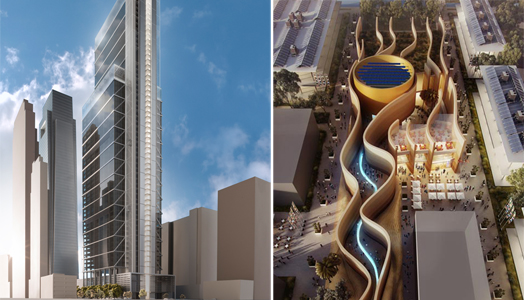Info & images: Foster+Partners
Foster + Partners reveal the designs of two of their latest
projects - Comcast Innovation & Technology Centre and United Arab Emirates pavilion at the 2015
Milan Expo...
While the former is
proposed as $1.2 billion, 59-story, 1,121-foot tower that will
neighbor Comcast Corporation’s global headquarters in Center City Philadelphia,
and become a dedicated home for the company’s growing workforce of
technologists, engineers, and software architects, the later is a contemporary reinterpretation in the
sustainable Masdar City masterplan in Abu Dhabi as a site-specific pavilion for
the 2015 Milan Expo.
The glass and stainless
steel tower of the Comcast Centre, expected to be the tallest building in the United
States outside of New York and Chicago is a unique and sustainable model for
mixed-use, high density development, which uniquely combines spaces for high
tech research and development with recreation facilities and a significant
public reception space – a window on Philadelphia.
While the ‘urban room’ embraces the city at the ground level; it links directly into the below-ground public transport system. Above this, the highly flexible loft-like spaces and studios are designed for a dynamic way of working – an engine for the city’s evolution as the kind of leading technology hub presently associated with Silicon Valley.
Chosen yet again to create
the national pavilion for the UAE, Foster+Partners’ design of the proposed
pavilion maximizes the opportunities presented by an elongated site – the
dramatic canyon-like entrance defined by two undulating 12-metre-high walls will
welcome people inside, and the channels between the high walls provide
intuitive circulation, naturally leading visitors to the auditorium, exhibition
and restaurant spaces.
The walls continue throughout the 140 metre site in a series of parallel waves, unifying the visitor spaces within a dynamic formal language designed to evoke the ridges and texture of sand dunes. To convey a distinctive sense of place, the texture of the walls derives from a scan taken in the desert and construction will utilize materials to represent the different shades of sand across the Emirates. The GRC panels are supported by a steel frame, which can be easily demounted and reconstructed for the pavilion’s eventual relocation in the UAE.
The design is further enhanced by interactive displays, digital talks and augmented reality devices that help to bring the story of the Emirates to life; including a special exhibit celebrating Dubai as host city for the 2020 Expo.
The design targets LEED
‘Platinum’ through a combination of passive principles and active techniques,
from rainwater capture on the roof garden to the integration of photovoltaic
cells.


.jpg)
.jpg)
.jpg)
.jpg)
.jpg)
.jpg)
No comments :
Post a Comment